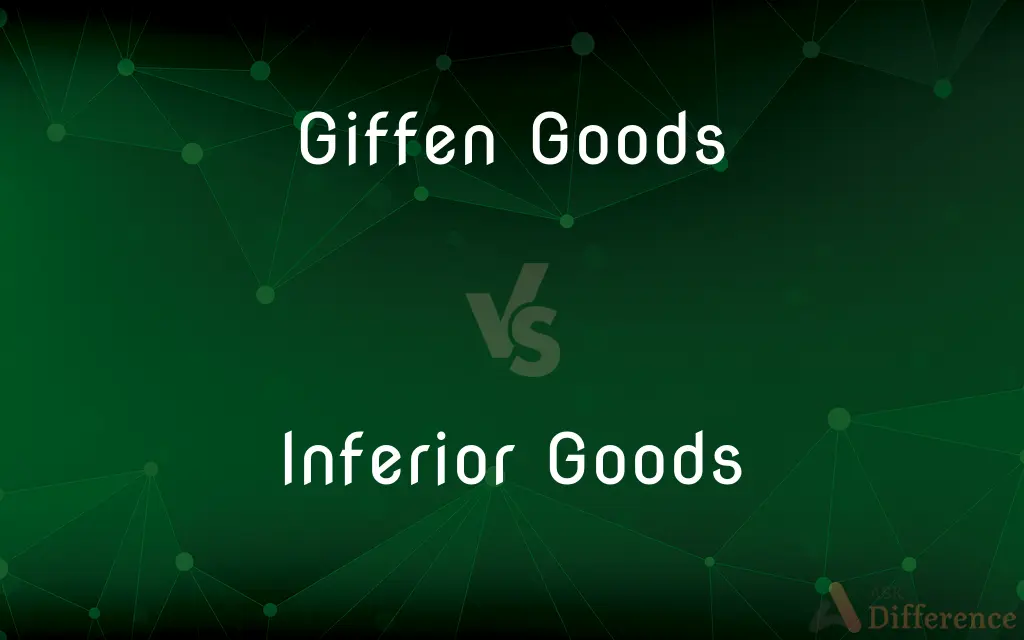Giffen Goods vs. Inferior Goods — What's the Difference?
By Tayyaba Rehman — Published on December 31, 2023
Giffen Goods are those where demand rises as price increases, while Inferior Goods see increased demand when income decreases, but not necessarily tied to price.

Difference Between Giffen Goods and Inferior Goods
Table of Contents
ADVERTISEMENT
Key Differences
Giffen Goods and Inferior Goods are unique concepts in economics, showcasing non-standard consumer behavior. Giffen Goods are rare commodities where an increase in price leads to an increase in quantity demanded, defying the general law of demand. On the other hand, Inferior Goods are products for which demand increases when consumers' incomes decrease, reflecting their "inferior" nature compared to other goods.
For Giffen Goods, the classic example is that of staple foods like bread in some historical contexts. If the price of bread rose, some consumers might buy more bread and less of more expensive food like meat, leading to an increase in the demand for bread. In contrast, Inferior Goods might include off-brand products or items of lower quality. When consumers face financial constraints, they might opt for these cheaper alternatives over more expensive or premium products.
It's important to note that all Giffen Goods are Inferior Goods, but not all Inferior Goods are Giffen Goods. The distinguishing feature of Giffen Goods is the direct relationship between price and quantity demanded. Inferior Goods, however, are categorized based on the inverse relationship between consumer income and demand, irrespective of their price behavior.
In the realm of consumer behavior, Giffen Goods present a paradox. Most goods obey the law of demand, where an increase in price reduces demand. But Giffen Goods are exceptions. Inferior Goods, meanwhile, highlight the substitutions consumers make based on their financial standing, opting for cheaper goods when income falls.
The recognition of Giffen Goods and Inferior Goods serves as an essential reminder that consumer behavior can be complex. It underscores that factors beyond price, such as consumer income and the availability of substitutes, play a crucial role in demand patterns.
ADVERTISEMENT
Comparison Chart
Price-Demand Relationship
Demand rises with price increase.
Not necessarily tied to price.
Income-Demand Relationship
Not necessarily tied to income.
Demand rises as income decreases.
Rarity
Very rare and specific cases.
More common than Giffen Goods.
All are...
All Giffen Goods are Inferior Goods.
Not all Inferior Goods are Giffen Goods.
Behavior Anomaly
Defies the general law of demand.
Showcases substitution based on income changes.
Compare with Definitions
Giffen Goods
Giffen Goods are products where demand grows as prices rise.
In some contexts, bread acted as a Giffen Good.
Inferior Goods
They highlight the substitutions consumers make based on financial constraints.
Thrift store items can be Inferior Goods for those with tighter budgets.
Giffen Goods
Their price increase can lead to reduced consumption of more expensive substitutes.
If rice, a Giffen Good, becomes pricier, people might consume less meat.
Inferior Goods
Inferior Goods are those where demand rises as consumer income falls.
Off-brand products often become popular Inferior Goods during recessions.
Giffen Goods
They often lack close substitutes, leading to increased consumption.
The lack of alternatives can cause some essentials to behave like Giffen Goods.
Inferior Goods
As income increases, consumption of these goods tends to decrease.
With a salary bump, some might replace Inferior Goods with brand-name items.
Giffen Goods
Their peculiar behavior is more an exception than a norm.
Observing a Giffen Good in action can be challenging due to its rarity.
Inferior Goods
They're typically cheaper alternatives to more premium products.
Public transport is an Inferior Good for many who'd prefer private cars.
Giffen Goods
These are rare exceptions to the general law of demand.
Historically, certain staples became Giffen Goods during famines.
Inferior Goods
Their nature is determined by income changes, not necessarily price shifts.
Even if the price of an Inferior Good remains stable, a salary decrease can boost its demand.
Common Curiosities
How do Inferior Goods respond to a decrease in consumer income?
Demand for Inferior Goods typically rises when consumer income falls.
What's the primary distinction between Giffen Goods and Inferior Goods?
Giffen Goods see increased demand with price rise, while Inferior Goods see increased demand with income fall.
What happens to the demand for Giffen Goods when their price rises?
For Giffen Goods, demand increases as the price rises.
Why are Giffen Goods so rare?
Giffen Goods defy the standard law of demand, making their real-world occurrence rare and specific to certain conditions.
Do Giffen Goods have many substitutes?
Giffen Goods often lack close substitutes, contributing to their unique demand behavior.
Can a good be both Giffen and Inferior simultaneously?
While all Giffen Goods are Inferior Goods, not all Inferior Goods display the Giffen paradox of rising demand with rising price.
Are all Giffen Goods also Inferior Goods?
Yes, all Giffen Goods are Inferior Goods, but the reverse isn't true.
Can luxury items be considered Inferior Goods?
No, Inferior Goods are typically cheaper alternatives, whereas luxury items demand increases with income.
How do Giffen Goods impact consumer budgets?
Giffen Goods can cause consumers to spend more on them and less on other, perhaps more expensive, items.
Why is it challenging to find real-world examples of Giffen Goods?
Their behavior is counterintuitive and specific to certain conditions, making them hard to observe and verify in the real world.
Can a good transition from being normal to Inferior or vice versa?
Yes, based on changing economic conditions and consumer preferences, goods can shift categories.
What's an example of an Inferior Good?
Off-brand products or public transportation can be Inferior Goods for some consumers.
Do consumers always prefer normal goods over Inferior Goods?
Not necessarily. Inferior Goods are often preferred when financial constraints arise or income falls.
What happens to the demand for Inferior Goods when their price rises?
The demand behavior of Inferior Goods concerning price isn't fixed; their defining feature is the relation to income, not price.
Are Inferior Goods always of lower quality?
Not necessarily. "Inferior" in this context refers to the economic relationship with income, not the quality of the product.
Share Your Discovery

Previous Comparison
Molecularity of Reaction vs. Order of Reaction
Next Comparison
Formula Mass vs. Molecular MassAuthor Spotlight
Written by
Tayyaba RehmanTayyaba Rehman is a distinguished writer, currently serving as a primary contributor to askdifference.com. As a researcher in semantics and etymology, Tayyaba's passion for the complexity of languages and their distinctions has found a perfect home on the platform. Tayyaba delves into the intricacies of language, distinguishing between commonly confused words and phrases, thereby providing clarity for readers worldwide.













































